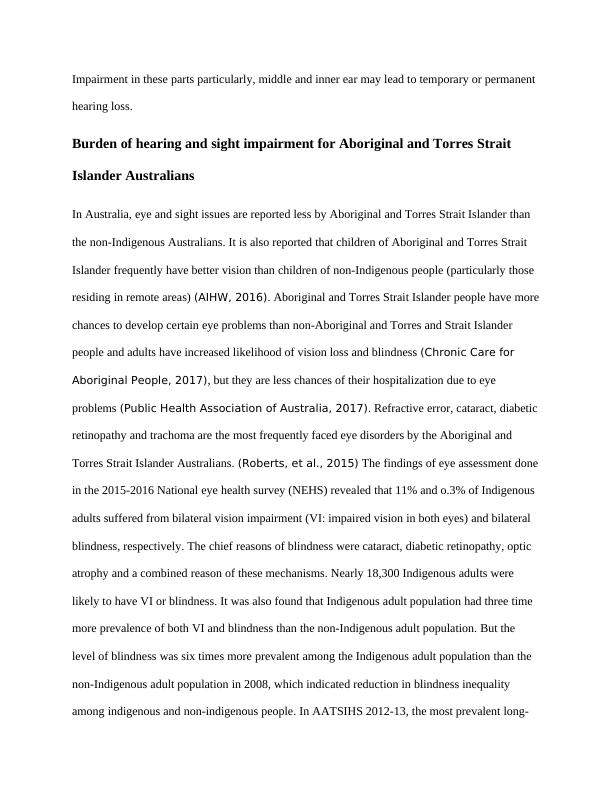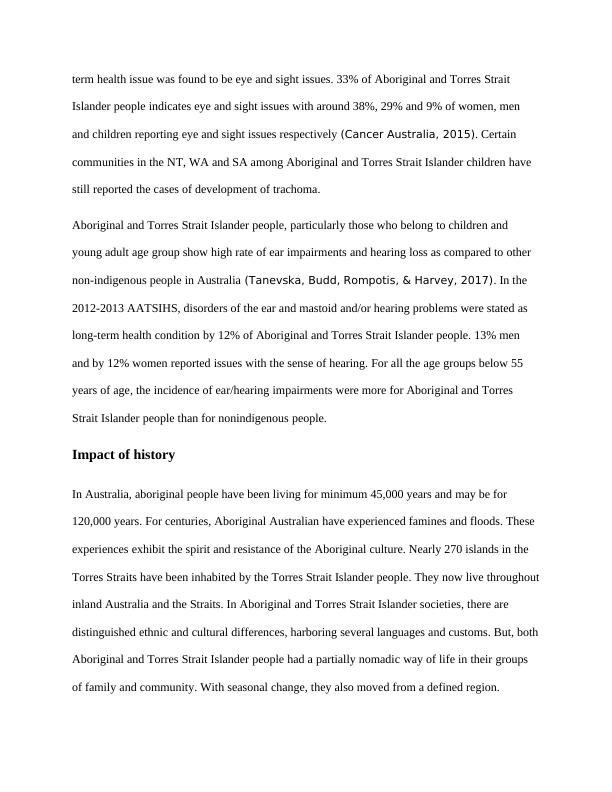Introduction Australia’s Governments has been facing the
Added on 2022-12-28
7 Pages1972 Words1 Views
Introduction
Australia’s Governments has been facing the challenge of improvement of the health conditions
of Aboriginal and Torres Strait Islander people from a long time. Even though some
improvements have been achieved in certain areas since the 1970s such as infant mortality
health, overall improvement has been slow and incoherent. Impairment of human senses such as
vision and sight can result in negative implications in areas such as education, employment,
social engagement and independent living. Aboriginal and Torres Strait Islander people in
Australia face increased incidence of various vision and hearing ailments than non-Indigenous
people. The report will elaborate these health issues in detail and compare their prevalence
among non-Indigenous people. The assignment will also mention the cultural implications and
barriers in addressing hearing and sight impairments for Aboriginal and Torres Strait Islander
Australians.
Describe the health issue
The sense of vision can be impaired due to various reasons such as genetics, ageing, premature
birth, disorders, infections, injuries, ultraviolet (UV) exposure, nutrition and tobacco use
(Australian Bureau of Statistics, 2016). An impaired vision can restrict the prospects in
educational, employment and social network context. It may further enhance the likelihood of
injury and be a cause of dependency on assistance and other people (George Institute for
Global Health, 2017). A partial loss of sense of vision can also lower the ability of a person to
live on their own and enhance the chances of mortality (Australian Health Ministers’
Advisory Council , 2017). Ear has three main parts which are external, middle and inner ear
and disorders of the ear are categorized based on the part in which the disease develops.
Australia’s Governments has been facing the challenge of improvement of the health conditions
of Aboriginal and Torres Strait Islander people from a long time. Even though some
improvements have been achieved in certain areas since the 1970s such as infant mortality
health, overall improvement has been slow and incoherent. Impairment of human senses such as
vision and sight can result in negative implications in areas such as education, employment,
social engagement and independent living. Aboriginal and Torres Strait Islander people in
Australia face increased incidence of various vision and hearing ailments than non-Indigenous
people. The report will elaborate these health issues in detail and compare their prevalence
among non-Indigenous people. The assignment will also mention the cultural implications and
barriers in addressing hearing and sight impairments for Aboriginal and Torres Strait Islander
Australians.
Describe the health issue
The sense of vision can be impaired due to various reasons such as genetics, ageing, premature
birth, disorders, infections, injuries, ultraviolet (UV) exposure, nutrition and tobacco use
(Australian Bureau of Statistics, 2016). An impaired vision can restrict the prospects in
educational, employment and social network context. It may further enhance the likelihood of
injury and be a cause of dependency on assistance and other people (George Institute for
Global Health, 2017). A partial loss of sense of vision can also lower the ability of a person to
live on their own and enhance the chances of mortality (Australian Health Ministers’
Advisory Council , 2017). Ear has three main parts which are external, middle and inner ear
and disorders of the ear are categorized based on the part in which the disease develops.

Impairment in these parts particularly, middle and inner ear may lead to temporary or permanent
hearing loss.
Burden of hearing and sight impairment for Aboriginal and Torres Strait
Islander Australians
In Australia, eye and sight issues are reported less by Aboriginal and Torres Strait Islander than
the non-Indigenous Australians. It is also reported that children of Aboriginal and Torres Strait
Islander frequently have better vision than children of non-Indigenous people (particularly those
residing in remote areas) (AIHW, 2016). Aboriginal and Torres Strait Islander people have more
chances to develop certain eye problems than non-Aboriginal and Torres and Strait Islander
people and adults have increased likelihood of vision loss and blindness (Chronic Care for
Aboriginal People, 2017), but they are less chances of their hospitalization due to eye
problems (Public Health Association of Australia, 2017). Refractive error, cataract, diabetic
retinopathy and trachoma are the most frequently faced eye disorders by the Aboriginal and
Torres Strait Islander Australians. (Roberts, et al., 2015) The findings of eye assessment done
in the 2015-2016 National eye health survey (NEHS) revealed that 11% and o.3% of Indigenous
adults suffered from bilateral vision impairment (VI: impaired vision in both eyes) and bilateral
blindness, respectively. The chief reasons of blindness were cataract, diabetic retinopathy, optic
atrophy and a combined reason of these mechanisms. Nearly 18,300 Indigenous adults were
likely to have VI or blindness. It was also found that Indigenous adult population had three time
more prevalence of both VI and blindness than the non-Indigenous adult population. But the
level of blindness was six times more prevalent among the Indigenous adult population than the
non-Indigenous adult population in 2008, which indicated reduction in blindness inequality
among indigenous and non-indigenous people. In AATSIHS 2012-13, the most prevalent long-
hearing loss.
Burden of hearing and sight impairment for Aboriginal and Torres Strait
Islander Australians
In Australia, eye and sight issues are reported less by Aboriginal and Torres Strait Islander than
the non-Indigenous Australians. It is also reported that children of Aboriginal and Torres Strait
Islander frequently have better vision than children of non-Indigenous people (particularly those
residing in remote areas) (AIHW, 2016). Aboriginal and Torres Strait Islander people have more
chances to develop certain eye problems than non-Aboriginal and Torres and Strait Islander
people and adults have increased likelihood of vision loss and blindness (Chronic Care for
Aboriginal People, 2017), but they are less chances of their hospitalization due to eye
problems (Public Health Association of Australia, 2017). Refractive error, cataract, diabetic
retinopathy and trachoma are the most frequently faced eye disorders by the Aboriginal and
Torres Strait Islander Australians. (Roberts, et al., 2015) The findings of eye assessment done
in the 2015-2016 National eye health survey (NEHS) revealed that 11% and o.3% of Indigenous
adults suffered from bilateral vision impairment (VI: impaired vision in both eyes) and bilateral
blindness, respectively. The chief reasons of blindness were cataract, diabetic retinopathy, optic
atrophy and a combined reason of these mechanisms. Nearly 18,300 Indigenous adults were
likely to have VI or blindness. It was also found that Indigenous adult population had three time
more prevalence of both VI and blindness than the non-Indigenous adult population. But the
level of blindness was six times more prevalent among the Indigenous adult population than the
non-Indigenous adult population in 2008, which indicated reduction in blindness inequality
among indigenous and non-indigenous people. In AATSIHS 2012-13, the most prevalent long-

term health issue was found to be eye and sight issues. 33% of Aboriginal and Torres Strait
Islander people indicates eye and sight issues with around 38%, 29% and 9% of women, men
and children reporting eye and sight issues respectively (Cancer Australia, 2015). Certain
communities in the NT, WA and SA among Aboriginal and Torres Strait Islander children have
still reported the cases of development of trachoma.
Aboriginal and Torres Strait Islander people, particularly those who belong to children and
young adult age group show high rate of ear impairments and hearing loss as compared to other
non-indigenous people in Australia (Tanevska, Budd, Rompotis, & Harvey, 2017). In the
2012-2013 AATSIHS, disorders of the ear and mastoid and/or hearing problems were stated as
long-term health condition by 12% of Aboriginal and Torres Strait Islander people. 13% men
and by 12% women reported issues with the sense of hearing. For all the age groups below 55
years of age, the incidence of ear/hearing impairments were more for Aboriginal and Torres
Strait Islander people than for nonindigenous people.
Impact of history
In Australia, aboriginal people have been living for minimum 45,000 years and may be for
120,000 years. For centuries, Aboriginal Australian have experienced famines and floods. These
experiences exhibit the spirit and resistance of the Aboriginal culture. Nearly 270 islands in the
Torres Straits have been inhabited by the Torres Strait Islander people. They now live throughout
inland Australia and the Straits. In Aboriginal and Torres Strait Islander societies, there are
distinguished ethnic and cultural differences, harboring several languages and customs. But, both
Aboriginal and Torres Strait Islander people had a partially nomadic way of life in their groups
of family and community. With seasonal change, they also moved from a defined region.
Islander people indicates eye and sight issues with around 38%, 29% and 9% of women, men
and children reporting eye and sight issues respectively (Cancer Australia, 2015). Certain
communities in the NT, WA and SA among Aboriginal and Torres Strait Islander children have
still reported the cases of development of trachoma.
Aboriginal and Torres Strait Islander people, particularly those who belong to children and
young adult age group show high rate of ear impairments and hearing loss as compared to other
non-indigenous people in Australia (Tanevska, Budd, Rompotis, & Harvey, 2017). In the
2012-2013 AATSIHS, disorders of the ear and mastoid and/or hearing problems were stated as
long-term health condition by 12% of Aboriginal and Torres Strait Islander people. 13% men
and by 12% women reported issues with the sense of hearing. For all the age groups below 55
years of age, the incidence of ear/hearing impairments were more for Aboriginal and Torres
Strait Islander people than for nonindigenous people.
Impact of history
In Australia, aboriginal people have been living for minimum 45,000 years and may be for
120,000 years. For centuries, Aboriginal Australian have experienced famines and floods. These
experiences exhibit the spirit and resistance of the Aboriginal culture. Nearly 270 islands in the
Torres Straits have been inhabited by the Torres Strait Islander people. They now live throughout
inland Australia and the Straits. In Aboriginal and Torres Strait Islander societies, there are
distinguished ethnic and cultural differences, harboring several languages and customs. But, both
Aboriginal and Torres Strait Islander people had a partially nomadic way of life in their groups
of family and community. With seasonal change, they also moved from a defined region.

End of preview
Want to access all the pages? Upload your documents or become a member.
Related Documents
Health Disparity in Hearing, Sight and Other Senses among Aboriginal and Torres Strait Islander Population of Australialg...
|11
|2331
|233
Hearing, Sight and Other Senses: Implications for Indigenous Australianslg...
|9
|2342
|120
Health Complication Among the Indigenous People.lg...
|7
|1851
|16
Vision Impairment in Older Adultslg...
|4
|810
|133
Ear and Hearing Problems among Aboriginal and Torres Strait Islander Australianslg...
|10
|2477
|207
Primary Healthcare in Aboriginal and Torres Strait Islanderslg...
|11
|2901
|88
